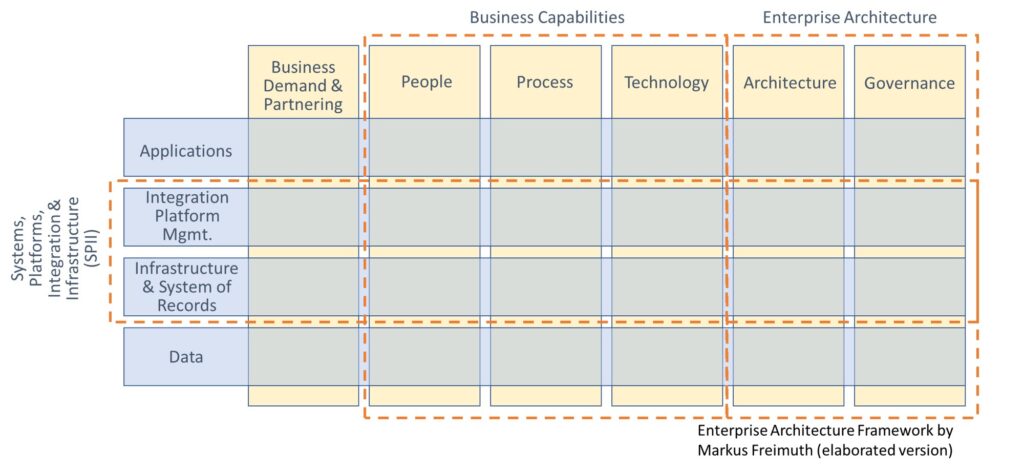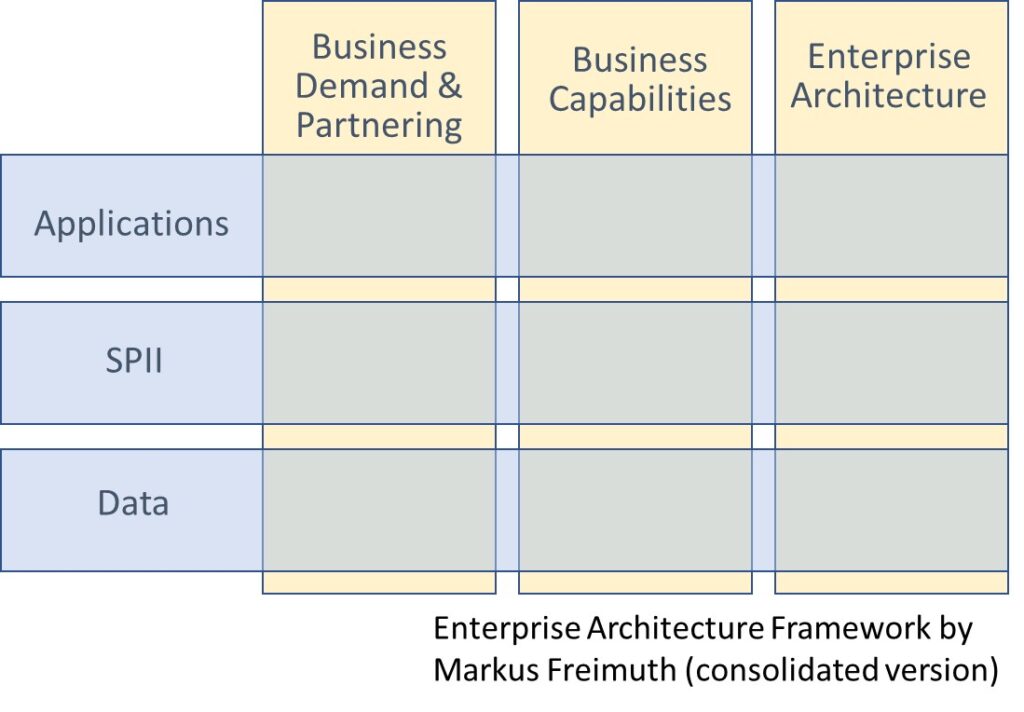Most enterprise architecture frameworks use architecture layers as a way to make the high complexity of an IT landscape understandable. Architecture layers can be understood as filters or slices of your IT landscape that only show a particular type or area. Traditional architecture layers would be something like business processes, applications, information technology, and a data layer. These layers depend a bit on which framework you look at, but somehow, most frameworks are quite similar to each other or even build upon each other. As most of them are quite old (from the 80s and 90s), many companies ask for adaptions to them or even do not believe in the benefit of such frameworks at all. (See here for an analysis of enterprise architecture frameworks) In this post, I suggest a framework of architecture layers that considers today´s business needs.
What were the drivers to develop the framework?
- One big trend is a tighter linkage between business and IT, sometimes called alignment, business partnering, or business enablement through IT.
- Another fact is that IT becomes more and more the source of revenue streams, instead of only a source for costs that the business needs to minimize. Many new business models are located at the heart of IT, such as platform, cloud, or data provisioning.
- The concept of business capabilities is strengthening its position in the heads of company leaders. Where earlier, people talked about processes (the HOW), there is today the concept of business capabilities (the WHAT), which is better suited when an abstraction of a topic is desired. However, there is no clear definition of what a business capability is yet so clarification is needed.
- IT has gained a lot of significance to the success of companies and the focus has shifted to the topic of common platforms, OS independent containers, and integration.
- The differentiation between a system of records and a system of engagement becomes more and more used. While the first needs stability and availability (e.g. an ERP system), the system of engagement is focused on customer interaction, “fanciness”, and providing the newest and coolest services and offerings.
- Due to the broad establishment of standards, compatibility, and cloud environments, there is a shift of priorities away from systems and infrastructures.
- Due to new digital opportunities and business models, as well as the introduction of new apps, there is a shift of priorities towards the application layer as well as the data layer.
How Does the Framework Look Like?
The framework represents a matrix, which shows an updated version of architecture layers horizontally and a more elaborated view of business and management categories, covering Business-IT alignment, Enterprise Architecture, and Business Capabilities, in the vertical axis.

The horizontal architecture layers are as follows:
- Applications that are used forend-user interaction (incl. application ecosystem of engagement)
- Integration Platform Management (incl. topics such as iPaaS, SOA, ESB, and Containers)
- Infrastructure and Systems of Record
- Data (incl. topics such as data lakes)
If you are familiar with typical enterprise architecture frameworks, you will notice that the business layer is not part of the horizontal view as it usually is. Instead, it is mentioned as a component that crosses through all architecture layers.
Moreover, the framework shows the layer “Integration Platform Management” and the layer “Infrastructure and Systems of Record” next to each other due to their close connections. They could also be combined as a layer called “Systems, Platforms, Integration & Infrastructure (SPII)”
On the vertical, the components are as follows:
- Business Demand & Partnering
- Architecture
- Governance
- Technology
- Process
- People
Although six components looks a lot, they can be consolidated to three major topics:
- Business Demand & Partnering
- Architecture and Governance represent the topic of Enterprise Architecture
- Technology, Process, and People represent the topic of Business Capabilities

The final and consolidated framework is shown below:

What are the benefits of the framework?
The framework focuses on business-IT alignment and positions IT as an equal partner to the business. On the one hand, it emphasizes that businesses can be directly interested in the data layer, not only indirectly via applications. On the other hand, it helps to differentiate between IT areas that business is more interested in (e.g. Apps and Data) and that it is less interested in (“my ERP, WLAN, and laptop just have to work!”).
As business capabilities are more stable than processes, they are better suited for a framework. In the presented framework, they are more prominently established including their components technology, process, and people. This allows a more differentiating view on the mapping of the business to its IT landscape. If you are unfamiliar with the concept of business capabilities, take a look at this post.
In this framework, the practice of enterprise architecture is clearly mentioned within the framework. Its components are the architecture (layers) itself (which is the core of most traditional frameworks), as well as its governance of it. Together, they form the enterprise architecture, which is relevant across the IT landscape. The framework provides therefore a more holistic view of the architecture and includes more business elements.
What is your opinion on the framework? Do you have suggestions? Would this framework work in your organization? I am curious about your ideas, discussion inputs, and to improve the framework further together!
